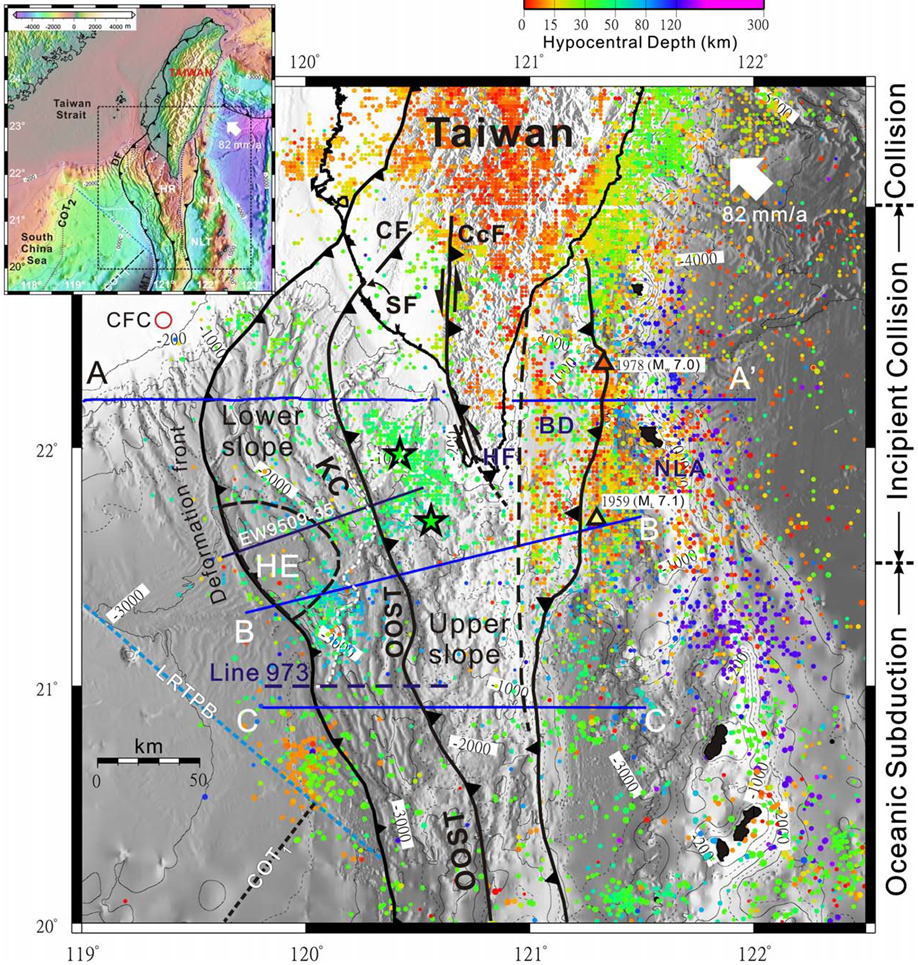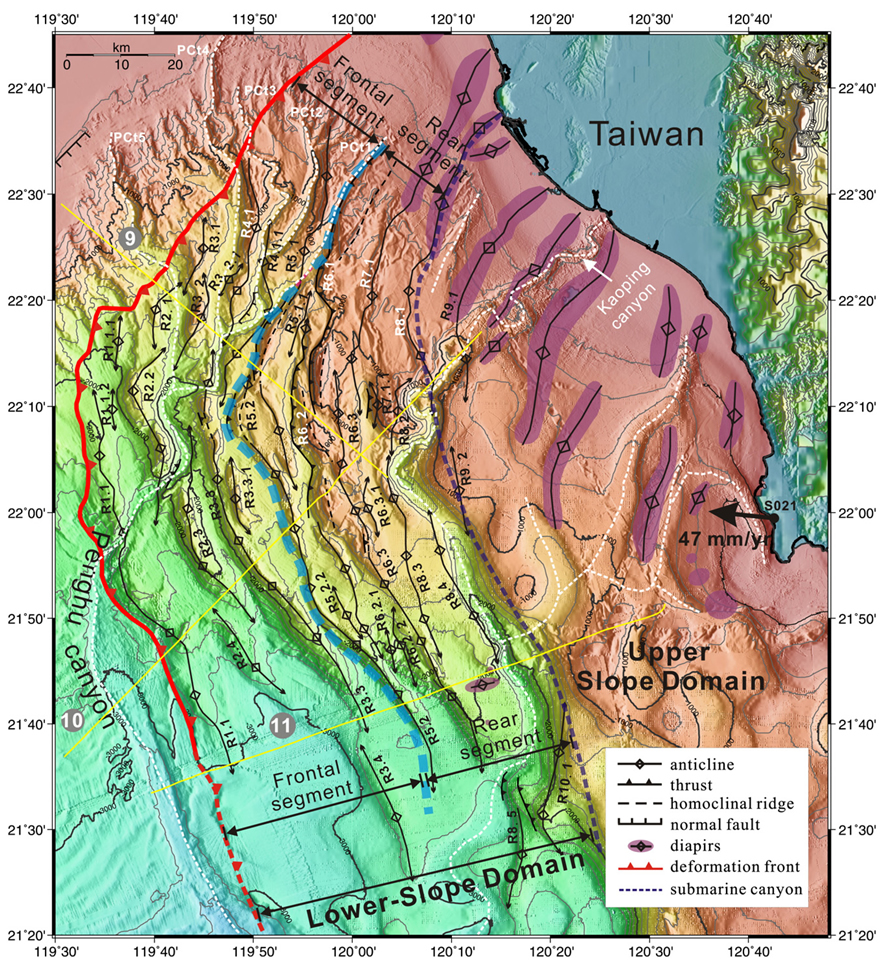
Incipient arc-continent collision zone
The areas of offshore and onshore southern Taiwan are in an initial stage of arc-continent collision, which consists of the overriding collisional/accretionary complex and the underthrusting Eurasian lithosphere separated by the Manila trench and deformation front. In this tectonic domain, We have been working on two directions of research.

(A) Structural and sedimentary architecture
We use new seismic reflection profiles and integrate existing data to reveal major tectonic features and potential seismogenic faults of the study area. The accretionary wedge in the incipient arc-continent zone can be divided into the lower slope, upper slope, and backthrust domains, respectively. These structural domains reflect different aspects of wedge deformation, and exhibit significant structural variations along-strike. Reflection seismic data show that the prominent seismogenic structures in the Taiwan incipient collisional wedge include: (1) frontal decollement beneath the lower-slope domain, (2) out-of-sequence thrusts (OOST) bordering the lower-slope and upper-slope domains, (3) megathrust that cuts into the oceanic (?) basement beneath the upper-slope domain, and (4) the Chaochou-Hengchun faults in the onshore upper-slope domain. Thermal regime for those structures indicates that the megathrust and part of frontal decollement are seismogenic. The geometry of the frontal decollement, out-of-sequence thrusts and megathrust is analogous to those observed along the Nankai prism of Japan, so that they are possibly capable of generating great earthquakes as shown in the Nankai Trough. (Lin et al., 2009, Tectonophysics, in press)

Off southwest Taiwan, a west-advancing orogenic wedge has obliquely impinged on the northern continental slope of the South China Sea (SCS) margin. We analyzed a dense grid of multi-channel seismic profiles to reveal the tectonic features in this oblique collision setting. In the upper SCS slope and adjacent to the accretionary wedge, the rifted continental margin is characterized by a deep-seated, oceanward-dipping, listric and active normal fault with rotated hangingwall strata beneath the slope. To the west of this slope segment, the mid-Oligocene to Recent post-breakup sediments show prograding and aggrading shelf-margin clinoforms that cover a series of small, possibly Paleogene, rift basins. In the submarine accretionary wedge, a series of west-vergent, NNW-striking fold-and-thrust structures characterizes the lower wedge, which can be further divided into frontal and rear segments with distinct structural features. The frontal segment is characterized by four west-vergent blind thrusts with gently folded limbs. In contrast, the rear, arcward segment is characterized by west-vergent, emergent and imbricate thrusts with tilted beds truncated at the hangingwalls. Strata within slope basins are tilted arcward, with dips that increase with depth, indicating continued relative uplift along thrust planes during sedimentation. Pulsed thrust activity is further evidenced by an array of
arcward-dipping unconformable surfaces with westward onlapping strata in the basins. Longitudinal sedimentary tapering of pre-orogenic sediments correlates strongly with curvature of the submarine frontal accretionary belt, suggesting that pre-orogenic sediment thickness is the major control on the geometry of frontal structures. The preexisting SCS slope that lies obliquely in front of the advancing accretionary wedge has impeded the advancing of frontal folds resulting in a successive termination of folds against and along strike of the SCS slope. The existence of the SCS slope also leads the strike of impinging folds with NNW-trend to turn more sharply to a NE-strike, parallel to strike of the SCS slope. Our analysis shows that the pre-orogenic mechanical/crustal heterogeneities and seafloor morphology exert strong controls on the thrust-belt development in the incipient Taiwan arc-continent collision zone. (Lin et al., 2008, Marine Geology)

Relevant publications:
Lin, A.T. , Liu, C.-S., Lin, C.-C., Schnurle, P., Chen, G.-Y., Liao, W.-Z., Teng, L.S., Chuang, H.-R., Wu, M.-S. 2008. Tectonic features associated with the overriding of an accretionary wedge on top of a rifted continental margin: An example from Taiwan . Marine Geology 255, 186-203, 10.1016/j.margeo.2008.10.002.
Lin, A.T. , Yao, B., Hsu, S.-K., Liu, C.-S., Huang, C.-Y. 2009. Tectonic features of the incipient arc-continent collision zone of Taiwan: Implications for seismicity . Tectonophysics, 10.1016/j.tecto.2008.11.004 (in press).